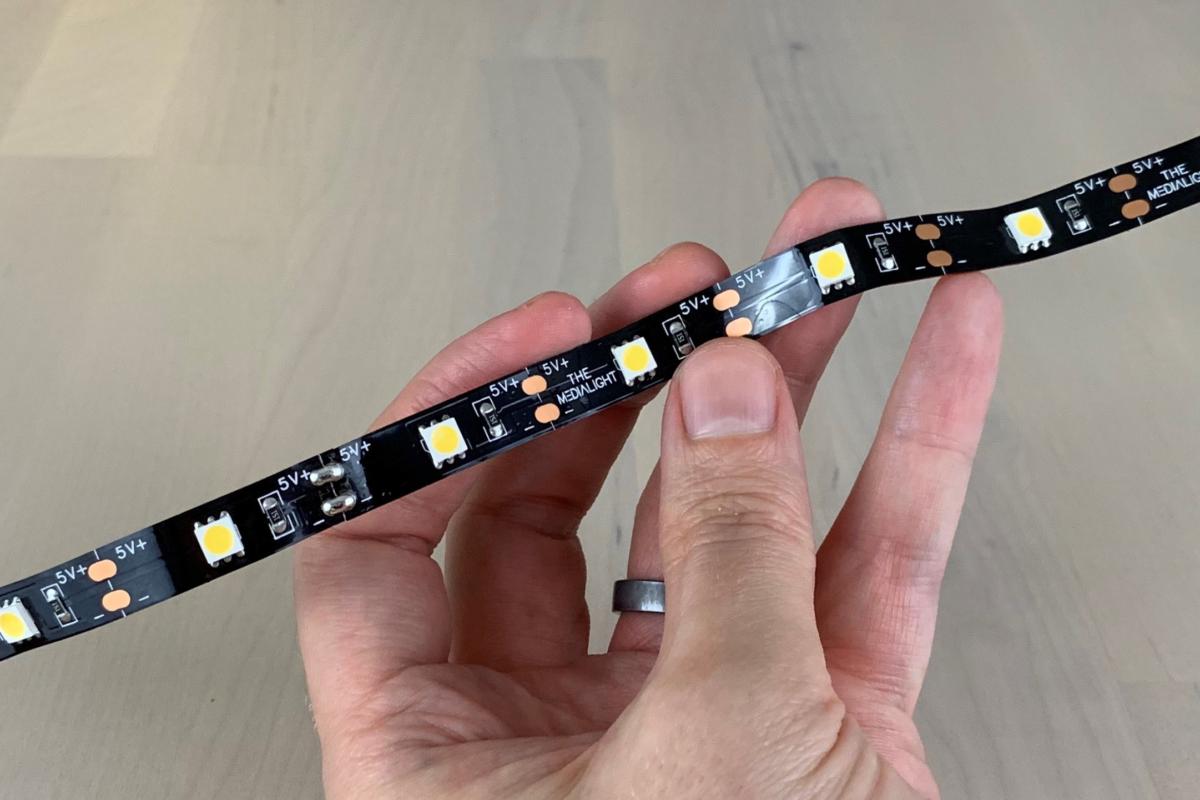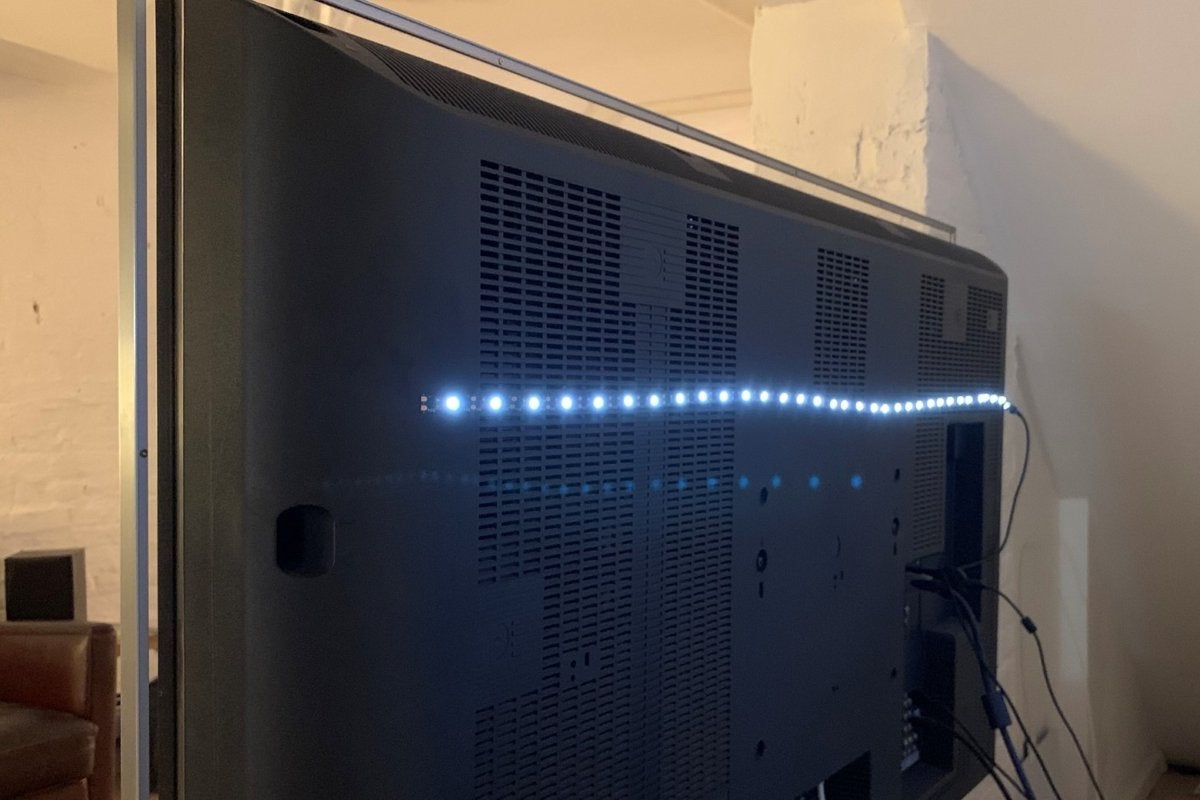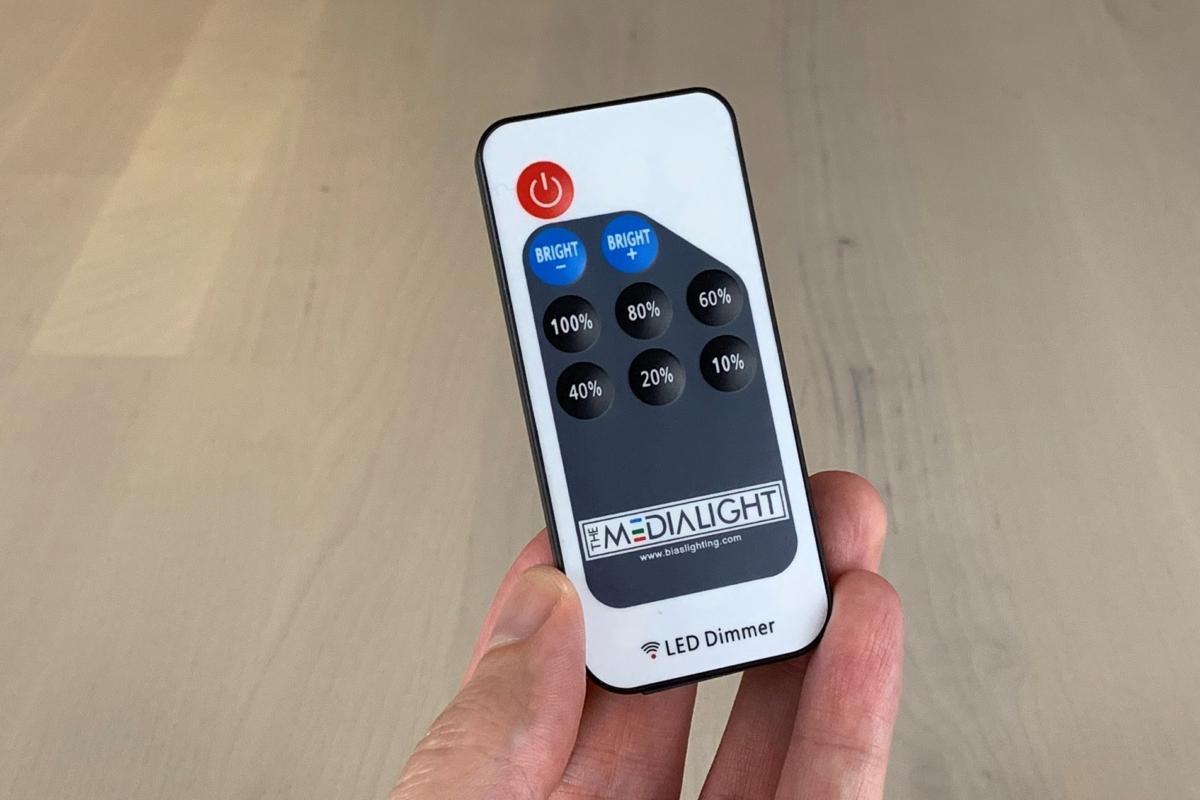Expert's Rating
Pros
- Produces white light with a color temperature of 6500K
- Easy to install
- IR remote allows for minute brightness adjustments
Cons
- LEDs don’t produce any color other than white
- More expensive and arguably less versatile than some competing products
Our Verdict
The MediaLight doesn’t produce an array of colors, and it can’t sync with your display, but this TV bias lighting system excels where it counts: Boosting your TV’s apparent contrast and reducing eye strain caused by watching a bright TV in a darkened room.
Don’t expect The MediaLight TV bias lighting to astound your friends with pulsing colors that match the shows on your screen. Designed for discerning viewers who want to enhance their TV’s visuals and ease eye strain while preserving the integrity of the original image, The MediaLight does an impressive job of replicating the same hazy daylight color temperature recommended by video-calibration experts. Easy setup, plus the ability to integrate the lights with universal remotes, round out the package.
Developed by Scenic Labs LLC, the publisher of such TV-calibration tools as Joe Kane’s Digital Video Essentials and the Spears & Munsil UHD HDR Benchmark, The MediaLight bias lighting system comes in a variety of shapes and sizes, ranging from the $25 The MediaLight Eclipse for PC monitors to the five-meter The MediaLight Mega, which goes for $110. I tested the $50 version of The MediaLight, a 55-inch LED strip that’s suitable for stand-mounted TVs up to about 72 inches.
 Ben Patterson/IDG
Ben Patterson/IDG
You can use a pair of scissors to cut The MediaLight bias lighting strip to fit your TV.
The MediaLight costs considerably more than the bargain-basement LED light strips you’ll find on Amazon (which sell for about $12 and up, depending on the length). It also lacks the ability to sync with your screen, which is either a pro or a con depending on who you’re talking to. On the one hand, passive bias lighting systems such as this are easier to set up, less distracting, and less likely to distort colors and “crush” black areas of the screen than responsive bias lights that match the colors on your TV. On the other hand, passive bias lights lack the dramatic effect of extending your screen to the walls surrounding it.
Installation and setup
Getting started with The MediaLight is a fairly painless process. I simply unfurled the roughly 55-inch strip, peeled off the backing from the adhesive, and carefully placed it widthwise across the back of my 46-inch Sony HDTV, about a third of the way down from the top (as recommended for TVs on a stand; wall-mounted TVs and bias lighting with synced colors do better with strips along all four sides of the screen). Looking back at my work, I can see a couple weaves and wobbles in my placement of the strip, but if those imperfections have any effect on The MediaLight’s performance, I haven’t noticed it.
 Ben Patterson/IDG
Ben Patterson/IDG
The MediaLight peel-and-stick bias lighting strip is easy to install on your TV. (You could use a bubble level during installation if you care enough to have the light strip be perfectly straight.)
SInce a 55-inch LED strip is too long for a 46-inch set, I used a pair of scissors to trim the strip down to size, being careful to cut along one of the thin white lines that designate safe spots for cutting. (Bias lighting strips from some other manufacturers can be snipped with scissors, too.)
The other end of the strip has a plug that connects to a USB adapter with an embedded power switch and IR sensor. If your TV has a rear USB port (it probably does), plugging The MediaLight strip into the USB port should power up the LEDs whenever you turn on the set.
Not all TV USB ports work alike, however, so you might need to use the included AC adapter for power. The strip also works with IR-enabled universal remotes or wireless bridges with IR blasters, so there’s a good chance you can control the LEDs with whatever control setup you have.
Features
You can adjust The MediaLight strip using the bundled IR remote, which lets you turn the LED strip on and off as well as control its brightness. The remote gives you more than 50 brightness steps, which allows for plenty of fine-tuning. Scenic Labs recommends that the LEDs should be no more than 10 percent as bright as your display, and the company provides a link to a YouTube test pattern to help you calibrate the brightness. I settled on one of the lowest brightness settings, which yielded a soft halo that wasn’t terribly distracting.
 Ben Patterson/IDG
Ben Patterson/IDG
The included IR remote boasts more than 50 steps of brightness levels, which allows for careful calibration.
The MediaLight isn’t designed to wow the senses or extend the reach of your screen; indeed, the company specifically points out that it’s aiming for “reference quality” bias lighting that boosts the colors and contrast on your screen without altering the picture that the filmmakers were trying to create. Specifically, The MediaLight’s ISF (Imaging Science Foundation) certification is tuned for a color temperature of about 6500K, the standard used by the video industry for how the color “white” should appear on a TV screen.
I was particularly curious to see how The MediaLight would benefit my 10-year-old Sony Bravia XBR TV, an aging 1080p set that nonetheless boasts a good contrast ratio for its vintage, but one that struggles when it comes to low-contrast, dimly lit scenes.
Performance
The MediaLight helped the most during bright letterboxed scenes, during which the top and bottom letterboxes looked inky black. They also helped to alleviate the light cloudy areas in the top corners of the Sony’s screen, which are generally most apparent when the screen is completely black or during credit sequences.
I still noticed grayish blacks during regular and darker scenes, but nothing stuck out at me like a sore thumb. More importantly, I saw no evidence of “crushed” blacks: a loss of detail in darker areas of the screen, which is a potential symptom of bias lighting that’s too bright.
Bias lights for TVs are also known for their ability to help ease eye strain, and while it’s impossible to quantify my level of visual comfort with The MediaLight on versus off, I did feel like I was squinting less at the screen than I usually do. Particularly at night, when my eyes are the most tired, I felt that watching shows and movies—especially during brighter scenes—was far less of a strain while using The MediaLight strips.
One of the highest compliments that I can pay The MediaLight bias lights is that I generally forgot they were there after I’d been watching for a few minutes; in other words, they did their job without getting in the way. That’s a big plus if you’re looking for a subtle improvement to your viewing experience, as well as a warning for those in the market for something more eye-popping.
Conclusion
The MediaLight TV bias lighting strips might not boast an array of colors or the ability to sync with your TV’s picture, but they excel at boosting the apparent contrast of your TV’s screen without distorting the colors in the image, and they help to ease eye strain while they’re at it. The MediaLight is far from being the least-expensive bias lighting system on the market, but it’s easy to install, the included IR remote allows for careful calibration, and it does its work better than anything the competition currently has to offer.

